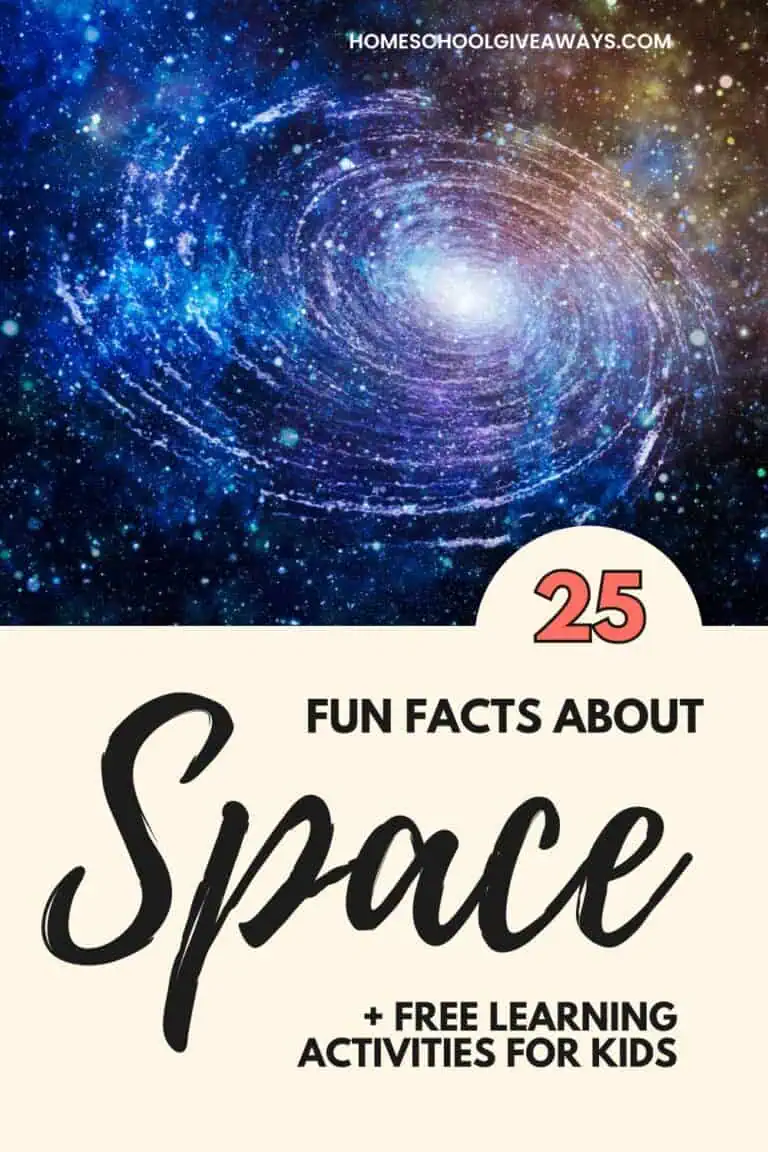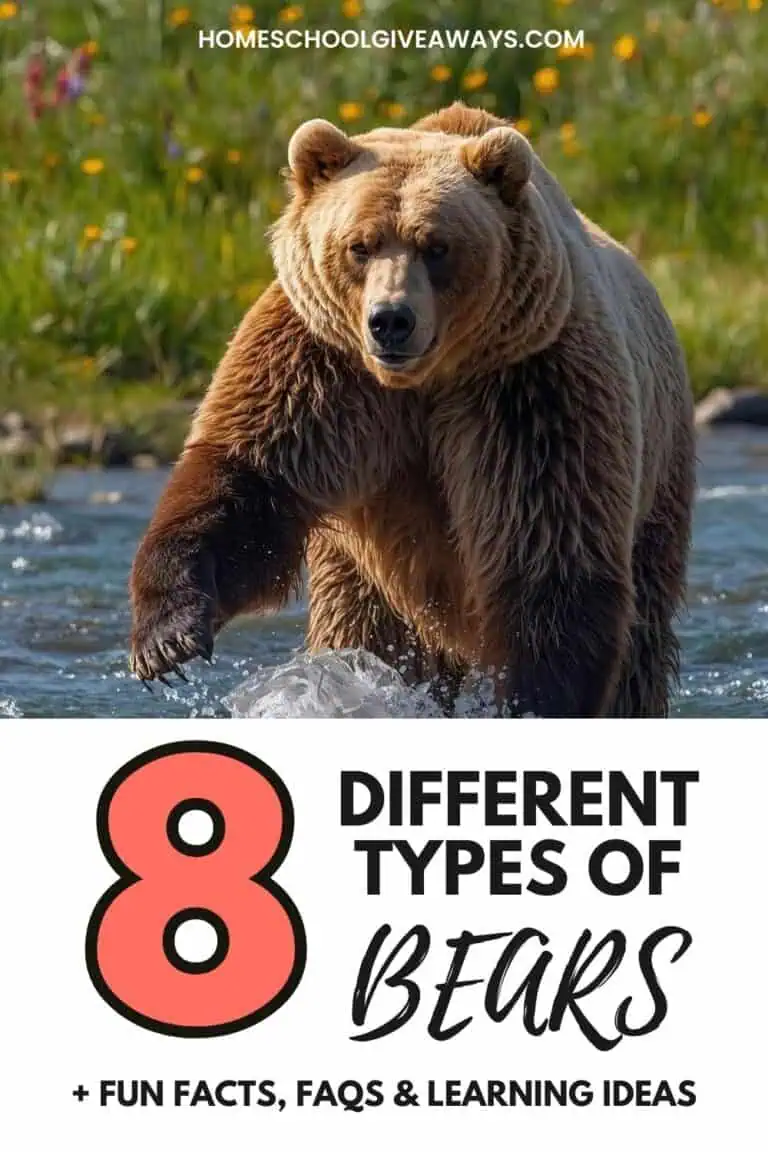50 Famous Explorers from History + Free Notebook for Kids
Published:
October 13, 2025

Contributor:
Charis King
Disclosure: This post may contain affiliate links, meaning if you decide to make a purchase via my links, I may earn a commission at no additional cost to you. See my disclosure for more info.
Famous explorers have always captured our imaginations – the brave men and women who set sail into the unknown, mapped uncharted lands, and crossed frozen oceans just to see what was on the other side. They dared to ask, “What’s out there?” and in doing so, changed how we see the world.
Studying explorers is more than just memorizing names and dates. It’s about understanding courage, curiosity, and the human drive to discover. When your kids learn about these seemingly fearless men, they’re learning geography, world history, navigation, and even perseverance – all through fascinating real-life adventures.
If you’d like to make this topic come alive without hours of prep, you’ll love our Discover the Great Explorers: A Notebooking Expedition. Kids can draw the explorer’s portrait, trace their routes, and record their discoveries. Each page includes prompts for research answers to:
- What was this explorer searching for?
- What lands or routes did they discover?
- When did they explore?
- What interesting facts make them memorable?
This ready-to-use homeschool resource includes 50 great explorers from around the world, each waiting to be studied, sketched, and discovered – ready for you to print and go!
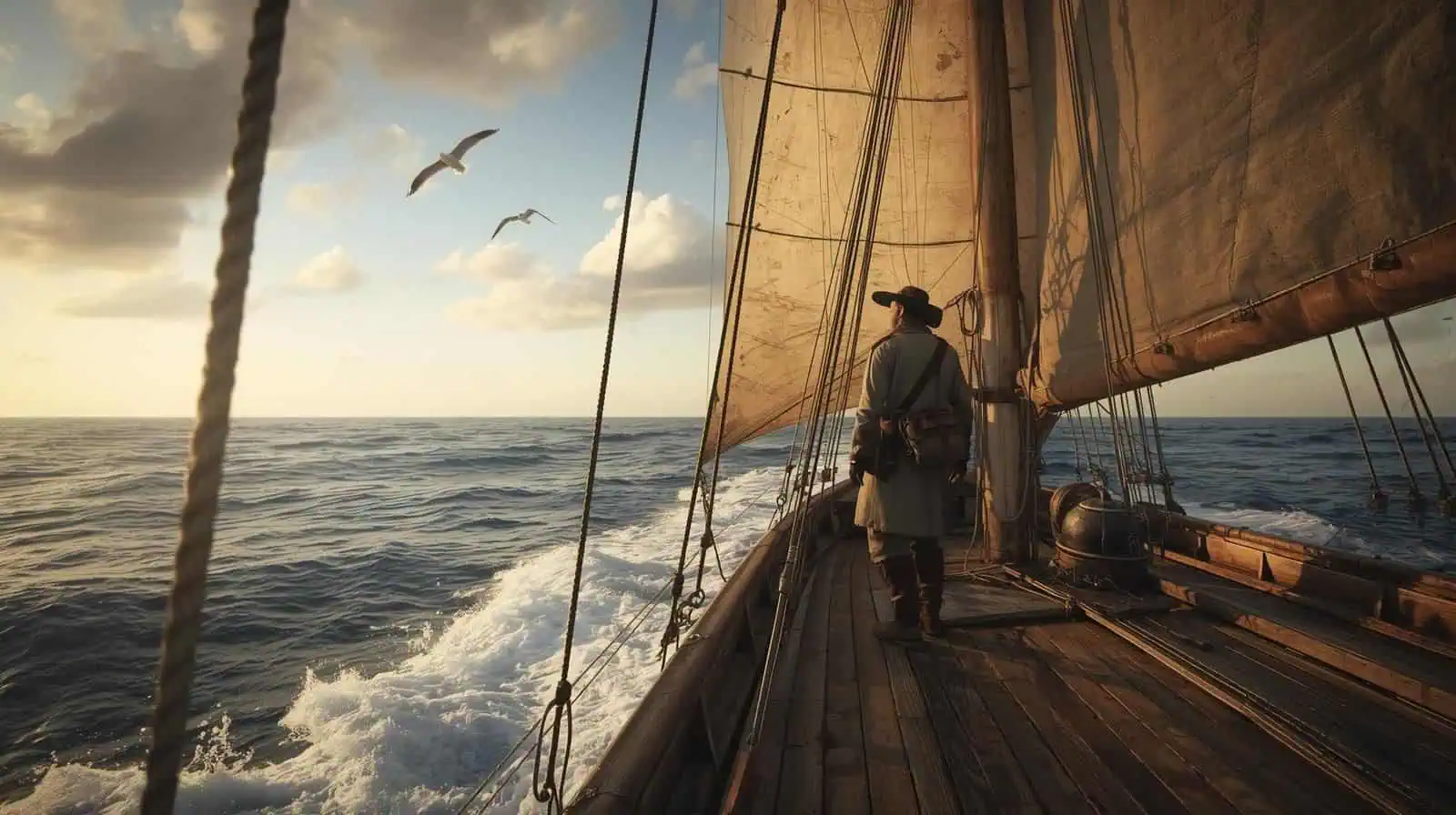
Why Study Famous Explorers?
Explorers changed the world. They mapped new territories, connected distant cultures, and often inspired innovation in science, trade, and exploration itself. Learning about explorers helps kids:
Visualize world geography in a hands-on way.
- Understand global history and cause-and-effect events.
- Recognize how exploration shaped countries, cultures, and commerce.
- Develop research and critical thinking skills.
And let’s be honest – what kid doesn’t love a good adventure story?
Meet 50 Famous Explorers
Here’s a look at the explorers featured in our Discover the Great Explorers | A Notebooking Expedition. Each one helped shape the map of the world we know today, and with 50 explorers to explore, you could study one per week for nearly a full year, perfect for a hands-on homeschool adventure.
1. Abel Janszoon Tasman – A Dutch navigator in the 1600s, Tasman was the first European to reach the islands of Tasmania and New Zealand. His voyages expanded Europe’s knowledge of the southern hemisphere. He charted coastlines that were completely unknown to European maps at the time.
2. Alexander Mackenzie – A Scottish-Canadian explorer who became the first European to cross North America north of Mexico. He traced rivers and rugged terrain all the way to the Pacific Ocean. His journey helped establish trade routes and opened the continent for future explorers.
3. Amerigo Vespucci – This Italian navigator realized that the lands Columbus found were part of a completely new continent. Vespucci’s voyages along South America helped map its coastline in detail. In recognition, the Americas were named in his honor.
4. Antoine Laumet de La Mothe Cadillac – A French explorer and trader, Cadillac founded the city of Detroit in 1701. He played a key role in expanding French settlements in North America. His leadership helped secure French influence along the Great Lakes.
5. Bartolomeu Dias – A Portuguese sailor who became the first European to round Africa’s southern tip, the Cape of Good Hope. This discovery opened the sea route to Asia. His daring expedition changed the future of global trade and navigation.
6. Charles Sturt – An Australian explorer who ventured into the continent’s interior in the 1800s. He traced the Murray and Darling Rivers and disproved myths about an inland sea. Sturt’s maps provided crucial knowledge about Australia’s dry interior.
7. Charles Wilkes – An American naval officer who led the U.S. Exploring Expedition in the 1830s. He charted islands across the Pacific and confirmed parts of Antarctica as a continent. His detailed surveys advanced scientific knowledge and mapping of distant lands.
8. Christopher Columbus – In 1492, Columbus sailed west across the Atlantic seeking a new route to Asia. Instead, he reached the Caribbean, opening the Americas to European exploration. His voyages marked the beginning of widespread contact between Europe and the New World.
9. David Livingstone – A Scottish missionary and explorer who spent decades exploring Africa. He searched for the source of the Nile and mapped large regions of central Africa. His travels combined adventure, geography, and humanitarian work.
10. Erik the Red – A Norse explorer exiled from Iceland, Erik sailed west to Greenland and founded the first European settlement there. He is remembered for daring voyages into icy, unknown seas. His settlements paved the way for later Viking exploration of North America.
11. Ernest Henry Shackleton – A British explorer famous for Antarctic expeditions in the early 1900s. He led men through extreme ice and snow, showing remarkable leadership under harsh conditions. His courage made him a symbol of endurance and exploration.
12. Ferdinand Magellan – A Portuguese navigator who led the first expedition to sail around the world. Although he was killed in the Philippines, his fleet completed the circumnavigation. Magellan proved that the Earth could be sailed around and that oceans were connected.
13. Sir Francis Drake – An English sea captain and privateer who became the first Englishman to circumnavigate the globe. He also raided Spanish ships and settlements, expanding England’s influence overseas. His adventures made him a hero of the Elizabethan era.
14. Francisco de Orellana – A Spanish explorer who became the first European to navigate the full length of the Amazon River. He traveled through dense jungle and encountered numerous native communities. His journey revealed the vastness and richness of the Amazon basin.
15. Francisco Pizarro – A Spanish conquistador who led the expedition that conquered the Inca Empire in Peru. He claimed vast territories for Spain and changed the history of South America. His bold actions reshaped the continent’s political and cultural landscape.
Print & Go: Famous Explorers Crossword
Put your knowledge of famous explorers to the test with this free ready-to-use crossword!
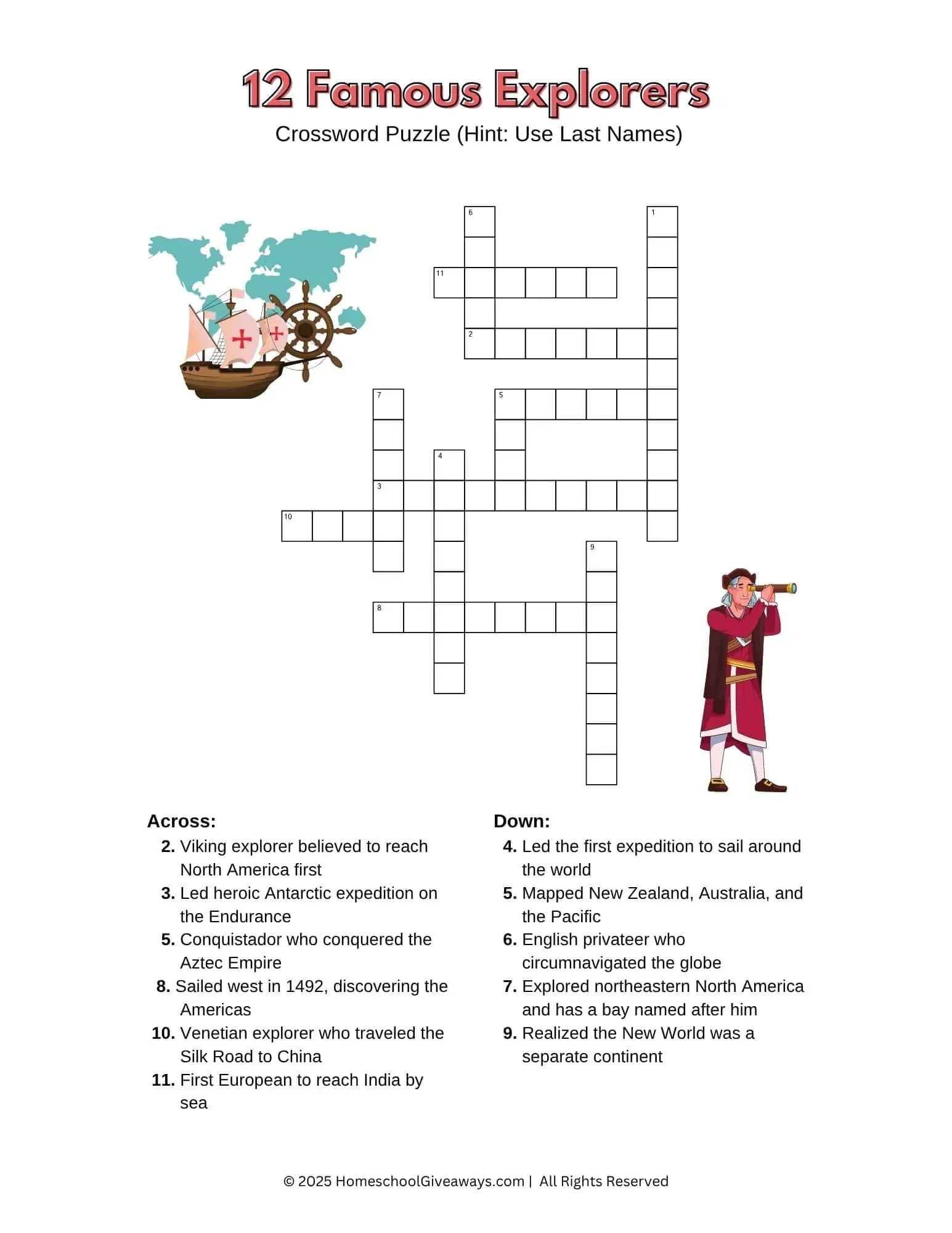
This activity uses last names only, so kids can focus on the most important part of each explorer’s name while recalling key facts about their journeys and discoveries. It’s a fun, no-prep way to reinforce learning and see how many explorers they remember from your study.
Perfect as a quick homeschool activity, a review page, or a printable challenge for history lovers of all ages!
16. Francisco Vázquez de Coronado – A Spanish explorer who searched for the legendary Seven Cities of Gold in the American Southwest. Though he never found the cities, he mapped vast regions of present-day Arizona, New Mexico, and Texas. His expeditions provided Europe with its first detailed look at the interior of North America.
17. George Grenfell – A British missionary and explorer who mapped large parts of the Congo River basin in the late 1800s. He documented previously unknown river systems and settlements. Grenfell’s work greatly expanded European knowledge of central Africa.
18. George Vancouver – A British naval officer who charted the Pacific Northwest coast of North America in the late 1700s. His detailed surveys of Alaska, British Columbia, and the Pacific coast were highly accurate. Vancouver’s maps guided explorers and settlers for decades.
19. Giovanni da Verrazzano – An Italian explorer sailing for France who mapped much of the Atlantic coast of North America, including New York Harbor. He sought a northern passage to Asia but found rich coastlines instead. His voyages helped establish France’s early presence in the New World.
20. Henry Hudson – An English navigator searching for a Northwest Passage to Asia. He explored the waters that now bear his name, including the Hudson River and Hudson Bay. Hudson’s voyages opened northern North America to European trade and settlement.
21. Hernán Cortés – A Spanish conquistador who led the expedition that conquered the Aztec Empire in Mexico. His military strategy and alliances with local tribes allowed him to claim vast territories for Spain. Cortés’s actions reshaped the cultural and political landscape of the Americas.
22. Hernando de Soto – Explored the southeastern United States in the 1500s and became the first European to cross the Mississippi River. He mapped rivers, mountains, and native communities along the way. De Soto’s journey provided Europe with valuable knowledge about North America’s interior.
23. Jacques Cartier – A French explorer in the 1500s who made three voyages to North America. He was the first European to explore the St. Lawrence River, mapping its waters and claiming lands for France. His journeys laid the foundation for future French settlements and expanded Europe’s knowledge of North America.
24. Jacques Marquette – A French Jesuit missionary who explored the Mississippi River with Louis Jolliet. He documented native villages, rivers, and lands unknown to Europeans. Marquette’s maps helped future explorers navigate the heart of North America.
25. James Cook – A British explorer who mapped the Pacific, New Zealand, and Australia in the 1700s. His precise charts transformed navigation and geography. Cook’s voyages introduced Europe to islands and peoples previously unknown to them.
26. Jedediah Strong Smith – An American frontiersman who explored the western United States in the early 1800s. He crossed deserts, rivers, and mountains that few Europeans had seen. Smith’s routes became critical paths for future settlers and traders.
27. Jim Bridger – One of the most famous mountain men of the American West. Bridger explored the Rockies, discovered passes, and guided pioneers across dangerous terrain. His knowledge helped shape western expansion in the United States.
28. John C. Frémont – An American explorer and mapmaker who explored the western territories in the 1800s. He mapped the Oregon Trail and the Great Basin. Frémont’s reports encouraged settlers to move west and helped define the U.S. frontier.
29. John Cabot – An Italian navigator sailing for England, Cabot reached the coast of North America in 1497. His voyage gave England its first claims in the New World. Cabot’s journey opened the door for future exploration and trade.
30. John Smith – Leader of the Jamestown Colony and explorer of the Chesapeake Bay region. Smith mapped rivers and forged relations with native tribes. His work helped ensure the survival of one of the first English settlements in North America.
31. Juan Ponce de León – A Spanish explorer credited with discovering Florida while searching for the Fountain of Youth. He also helped colonize Puerto Rico. Ponce de León’s voyages expanded Spanish influence in the Americas.
32. Leif Erikson (or Erkisson**) – A Viking explorer who likely reached North America around the year 1000, long before Columbus. He established a short-lived settlement called Vinland in what is now Newfoundland. Erikson’s journey is one of the earliest known European ventures to the continent.
Print & Go: Free Leif Erikson Notebook Pages
**Erikson is the common English spelling while Eriksson is used in Scandinavian languages. To help you homeschool, we have pages with both spellings. Our complete notebook pack in the Subscriber Library shows Eriksson, while the Print & Go pages below show it as Erikson
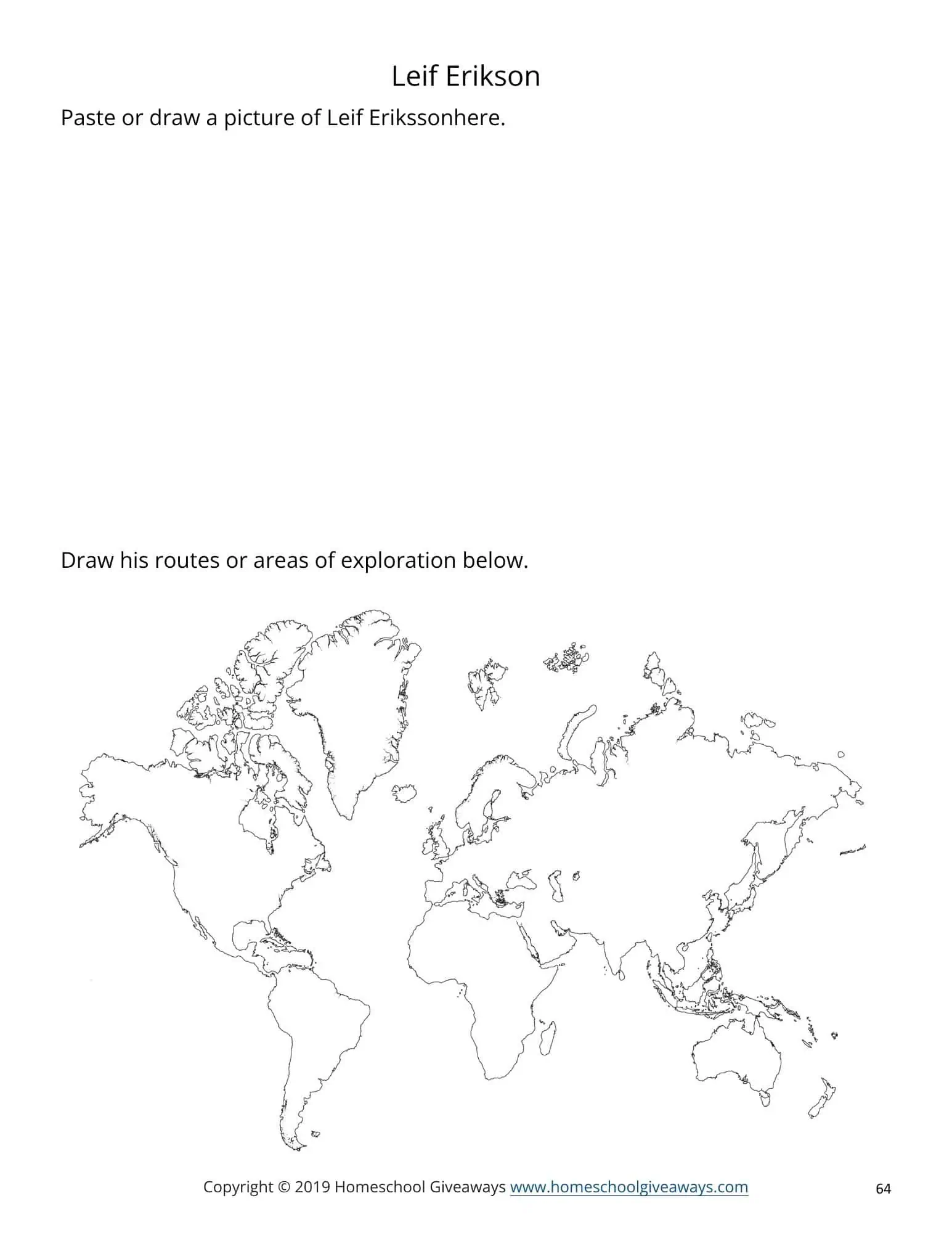
Bring Leif Erikson to life with these free sample pages of the full notebook pack:
- Draw a portrait of Leif Erikson and trace his journey from Greenland to Vinland.
- Answer research questions to explore more about his life and adventures.
Perfect for a no-prep homeschool activity or to celebrate Leif Erikson Day on October 9th.
33. Louis Jolliet – A French-Canadian explorer who traveled with Father Marquette along the Mississippi River. He mapped the river’s course and documented native communities. Jolliet’s expeditions opened up trade and exploration of central North America.
34. Marco Polo – A Venetian merchant and traveler who journeyed to China along the Silk Road. His accounts of Asia inspired future explorers to seek trade routes. Polo introduced Europe to the riches, cultures, and geography of the East.
35. Martin Frobisher – An English navigator searching for a Northwest Passage to Asia. He explored the Canadian Arctic and collected “fool’s gold” along the way. Frobisher’s voyages helped map the northern Atlantic coast.
36. Matthew Alexander Henson – An African American explorer who accompanied Robert Peary to the North Pole. He played a key role in navigating the Arctic and surviving extreme conditions. Henson’s achievements were long overlooked but were crucial to polar exploration.
37. Matthew Flinders – An English navigator who circumnavigated Australia and proved it was a continent. He charted its coastline with great accuracy. Flinders’ maps guided settlement and scientific study for decades.
38. Meriwether Lewis – Co-led the Lewis and Clark Expedition across the Louisiana Territory. He documented rivers, mountains, plants, animals, and native peoples. Lewis’s detailed journals expanded European knowledge of North America.
39. Mungo Park – A Scottish explorer who mapped the Niger River in West Africa in the late 1700s. He explored harsh landscapes and navigated unknown rivers. Park’s writings brought Africa’s geography to Europe for the first time.
40. René-Robert Cavelier, sieur de La Salle – Explored the Great Lakes and the Mississippi River, claiming vast lands for France. He established forts and trading posts along his routes. La Salle’s expeditions connected Canada to the Gulf of Mexico by river.
41. Richard E. Byrd – An American aviator and polar explorer who flew over the North and South Poles. He conducted scientific observations and mapped unknown areas. Byrd’s flights expanded modern exploration techniques and Arctic knowledge.
42. Samuel de Champlain – Founded Quebec City and explored eastern Canada. He mapped rivers, lakes, and settlements while forming alliances with native peoples. Champlain’s work established the foundation of New France.
43. Sebastian Cabot – Son of John Cabot, he explored South America and parts of North America. Cabot continued to expand England’s presence overseas. His voyages advanced European trade and mapping of the New World.
44. Simon Fraser – A Canadian explorer who charted the Fraser River in British Columbia. He navigated dangerous rapids and mapped the surrounding mountains. Fraser’s work was essential for understanding western Canada’s geography.
45. Thomas Cavendish – An English navigator who circumnavigated the globe in the late 1500s. He raided Spanish ships along the way, combining exploration with privateering. Cavendish’s voyages demonstrated English naval power on a global scale.
46. Vasco da Gama – A Portuguese explorer who sailed directly from Europe to India. His voyage opened a sea route for trade with Asia. Da Gama’s achievement transformed global commerce and navigation.
47. Vasco Núñez de Balboa – Crossed the Isthmus of Panama and became the first European to see the Pacific Ocean from the Americas. His journey confirmed the vastness of the new world. Balboa’s expedition marked a major milestone in exploration history.
48. Vitus Bering – A Danish explorer sailing for Russia, Bering mapped the coast of Alaska and the strait that bears his name. He helped define the boundary between Asia and North America. His voyages expanded European knowledge of the northern Pacific.
49. William Clark – Co-led the Lewis and Clark Expedition, documenting the American West’s rivers, mountains, and wildlife. Clark’s maps and journals guided future settlers and explorers. He helped provide a detailed understanding of western North America.
50. Zebulon Montgomery Pike – An American explorer who led expeditions through the southern Louisiana Territory in the early 1800s. During his travels, he observed and mapped Pikes Peak, the tallest mountain in the Rocky Mountains’ southern region and one of Colorado’s most famous “fourteeners.” His reports provided one of the first detailed European accounts of the Rockies and the surrounding lands.
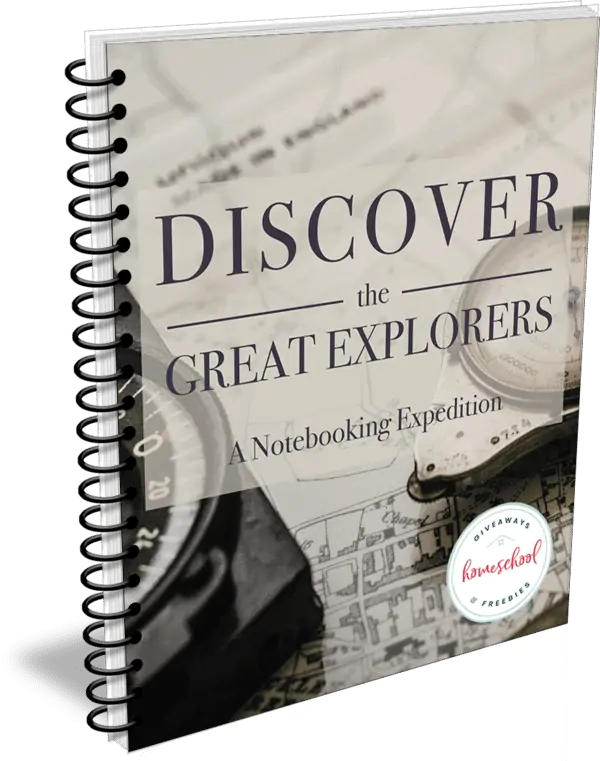
Discover the Great Explorers| A Notebooking Expedition
Bring history to life with the full Discover the Great Explorers| A Notebooking Expedition! This 100-page resource covers 50 famous explorers from around the world, giving kids the chance to trace routes, draw portraits, and dive into the stories of these incredible adventurers.
Perfect for hands-on, no-prep homeschooling, it encourages research, creativity, and independent learning while making history interactive and fun. The full set is available in our Subscriber Library and All-Access Document Library, ready for your family to explore the journeys that shaped our world.
Springboard Learning Ideas
Learning about explorers doesn’t have to be just reading maps and dates. Here are a few hands-on ideas to make it more engaging for your kiddos:
- Create a “Map of Discoveries.” Hang a large world map and mark each explorer’s route with string or colored markers.
- Explorer Role Play. Let your kids dress up as explorers, pack an “expedition bag,” and present what they discovered.
- Build a Compass or Astrolabe. Learn how early explorers navigated by making simple navigation tools like a compass or astrolabe. Check out how to build a compass with this YouTube video.
- Host an Explorer Fair. Each child chooses an explorer to research and presents their journey to the family or homeschool group.
- Explorer Trading Cards – Create a card for each explorer with a portrait, key facts, routes they explored, and interesting achievements. Kids can trade cards, quiz each other, or make a matching game. Try one new card each week and by the end of the year you’ll have a full deck of 50 explorers.
- Adventure Journals – Write short “journal entries” as if your child were the explorer, describing discoveries, challenges, or encounters along the way. This helps them step into their shoes and really understand their journey.
Keep the excitement going with these books, videos, and online adventures that bring the stories of famous explorers to life!
Books About Famous Explorers
- Explorers: Amazing Tales of the World’s Greatest Adventurers by Nellie Huang – Travel through time with daring explorers who climbed the highest mountains, crossed vast oceans, and ventured into the unknown. This beautifully illustrated book gives kids a glimpse of real-life courage and discovery.
- Lives of the Explorers: Discoveries, Disasters (and What the Neighbors Thought) by Kathleen Krull – Meet the adventurers behind the history books in this fun and fascinating look at their triumphs, mistakes, and sometimes hilarious reputations. Kids will love the mix of storytelling and history.
Videos to Watch
- Age of Discovery: Exploring the New World (Part 1) – Step back in time to the Age of Discovery and join early explorers as they set sail across uncharted oceans in search of new lands. This video introduces the voyages that changed the world, from Columbus to other famous explorers who mapped the Americas. Perfect for learners of multiple ages, it brings history to life by showing how curiosity, courage, and navigation shaped the world we know today.
- Amerigo Vespucci: The Explorer Who Gave America Its Name – Do your elementary students know where America got its name? They’ll love time traveling with Leo and Layla to meet Italian explorer Amerigo Vespucci, the man who realized that the New World was a completely new continent. This fun adventure brings history to life while helping kids understand why his discoveries changed the map forever.
- John Cabot – European Explorer – Join John Cabot, an Italian explorer sailing under the English flag, as he embarks on a historic voyage across the Atlantic in 1497. This educational video introduces young learners to Cabot’s journey to North America, highlighting his landing on the coast of what is now Canada. Discover how Cabot’s exploration paved the way for future European exploration and settlement in the New World. A perfect resource for elementary students to learn about one of history’s pivotal explorers.
Explore Online
- The Mariners’ Museum and Park – Dive into exhibits, maps, and digital archives that explore humanity’s connection to the sea and those who dared to cross it.
Celebrate Exploration!
You can tie your explorer study into Leif Erikson Day on October 9th or Columbus Day on the 2nd Monday of October, both perfect times to celebrate curiosity, discovery, and the spirit of adventure. Whether you’re learning about ocean voyages or Arctic treks, these activities turn history lessons into a true voyage of learning.
Final Thought
Exploration isn’t just history – it’s a mindset. When your kids learn about the famous explorers who shaped our world, they see how curiosity, courage, and persistence can change everything. Remember to grab your Discover the Great Explorers: A Notebooking Expedition in our free subscriber library or all-access document library and let your next homeschool adventure begin!





